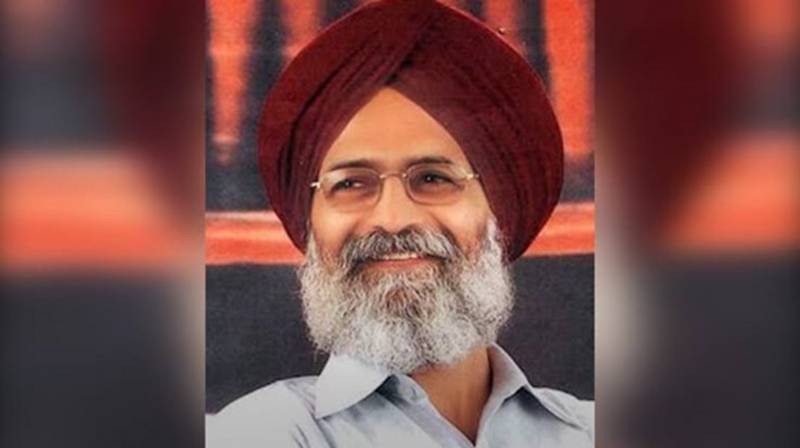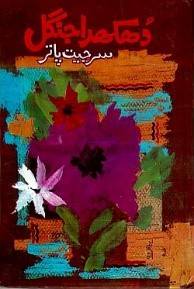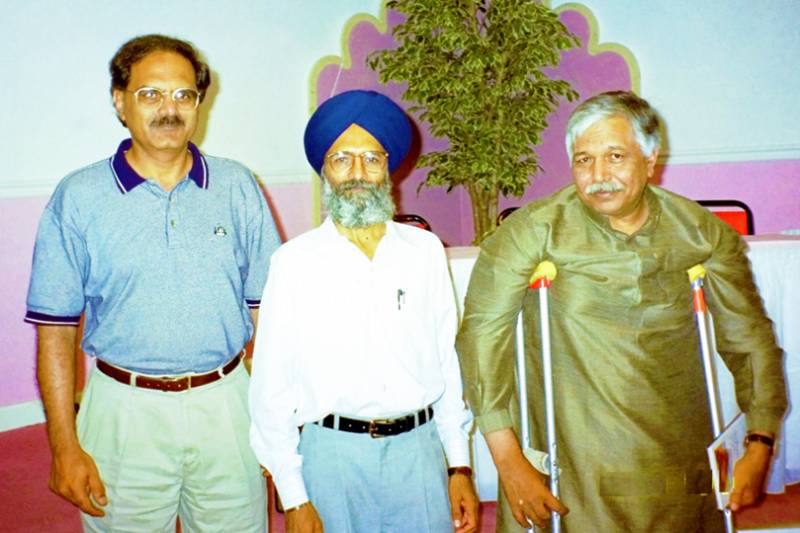
The recent demise of eminent Punjabi poet Surjit Patar (14 January 1945 – 11 May 2024) once again highlighted the increasing literary divide between the two Punjabs. In East Punjab, he was the most celebrated and critically acclaimed contemporary poet. He had become a household name and his popularity and admiration, adorned by love and respect from all, had reached a level that is rarely attained by Punjabi poets. In East Punjab as well as at the all-India level, he received the highest literary honours and awards including one of the highest civilian awards of India, the Padma Shri, in the field of literature and education, the prestigious Saraswati Samman award, the Sahitya Academy award for Punjabi poets and many more.
His funeral and cremation were attended by political leaders across party lines, senior government officials, the literary fraternity and a large number of well-wishers. He was cremated with full state honours. Punjab Chief minister Bhagwant Mann took part in carrying the coffin and laid a wreath to honour him. Newspapers across India carried headlines to mourn him. It was a sad day for Indian Punjabis living in India and abroad.
West Punjab on the other hand barely took notice of the loss of one of the greatest Punjabi poets of our times, Surjit Patar. This lack of recognition is not a new phenomenon.
Amrita Pritam (1919-2005) was well known in West Punjab primarily because of her famous poem "Ajj Aakhan Waris Shah Nu," which provided much-needed catharsis after the large-scale loss of life during the bloody riots following the 1947 partition of Punjab. Mohan Singh (1905-1978) was also known to the early post-partition generation of West Punjabis, as his poetry book "Saawe Patter" was taught in Lahore’s Oriental College both before and for a few years after the Partition.
However, the popularity of East Punjab’s Punjabi poets who gained prominence after the 1947 Partition has largely remained confined to East Punjab. When Shiv Kumar Batalvi (1936-1973) died, few people outside the small circle of Punjabi activists in West Punjab knew who he was. The same was the case with Pash (1950-1988) and now with Surjit Patar. Despite their significant contributions to Punjabi literature, these poets have not received the same level of recognition and appreciation in West Punjab.
More than the tightly controlled border and differences in written scripts, the primary reason for the growing gulf between Punjabi language and literature in the two Punjabs is the lack of Punjabi language education in West Punjab, where Urdu dominates literary, educational and all other aspects of language use while Punjabi has been pushed to a corner. This has distanced West Punjabis from their language, literature and culture. Until Punjabi is introduced in West Punjab from the primary level in schools, the literary and linguistic divide between the two Punjabs will continue to widen.
Surjit Patar was born in Patar Kalan, a village in the Jalandhar district. After completing his matriculation from a nearby village school, he graduated with a degree in Arts from Randhir College, Kapurthala. He went on to earn his master’s degree in literature from Punjab University, Patiala, and later completed his doctorate at Guru Nanak Dev University, Amritsar. The topic of his research was “Transformation of Folklore in Guru Nanak Vani.” He then pursued a career in academia. He began teaching at Punjab Agricultural University, Ludhiana, in 1972 and retired as a professor in 2005.
It was the poetry of pioneering modern poets like Mohan Singh and Harbhajan Singh, along with his close association with Shiv Kumar Batalvi and Pash, that awakened the poet within him. He began writing poetry in the mid-1960s. He had a melodious voice like Shiv Kumar Batalvi. In fact, he wanted to become a singer before he turned towards writing poetry. Initially it was his singing of his ghazals and songs that made him a big attraction at kavi darbars (poetry reading gatherings), but it was also obvious from the very beginning that he was destined to become a major Punjabi poet.
Some of his best poetry on the subject of migration, which Punjabis have experienced on a large scale during the last 150 years or more, is written in the form of ghazals
Writing ghazals is not native to Punjabi poetic traditions. This became a point of contention between Surjit Patar and Pash, who believed that gaining popularity through writing and singing ghazals might hinder Patar's potential to become a serious poet. In a letter from jail, where Pash was incarcerated for publishing his revolutionary poetry collection Loh Katha, he wrote to Patar, "You are a sensitive poet, but I am not happy with you writing ghazals. Popularity is a noose around your neck. Don't let it sway you."

Patar did not pay attention to this advice, which turned out to be a bonanza for Punjabi poetry. While he wrote most of his poetry in the form of poems and songs, some of his masterpiece poetry has also been composed in the ghazal genre. He wrote some of the finest Punjabi ghazals, skilfully blending this traditional form of Persian and Urdu poetry with Punjabi sensibilities, thereby expanding the horizons of Punjabi literature.
Departing from Urdu and Farsi traditions, the themes of his ghazals were not primarily about his longing for or separation from his beloved. Ghazal was just another vehicle for him to express his views on the same serious subjects that were the focus of his poems. For instance, some of his best poetry on the subject of migration, which Punjabis have experienced on a large scale during the last 150 years or more, is written in the form of ghazals.
Patar had personally experienced the impact of migration when his father migrated to Kenya to support his family during Patar’s childhood and could not come home except for a brief visit once every five years. Patar captured in a beautiful and poignant ghazal “Chal Patar hun dhoondan chaliye, bhuliyan hoiyaan thanwan” the essence of the immense loss migrants had to endure in the form of what they leave behind. He also touched upon the well know phenomenon of the loss of creativity among migrant writers.
| چل پاتر ہُن ڈھونڈن چلیے، بھلیاں ہویاں تھانواں | کِتھے کِتھے چھڈ آئے ہاں، اَن لکھیاں کویتاواں | |
| گڈی چڑھن دی کاہل بڑی سی،کیہ کُجھ رہ گیا اوتھے | پلاں چھِناں وچ چھڈ آئے ساں، یُگاں یُگاں دیاں تھانواں | |
| ادھی رات ہوئے گی، میرے پنڈ اُتے ایس ویلے | جاگدیاں ہوون گیاں، سُتیاں پُتراں لاگے ماواں | |
| میرے لئی جو تیر بنے سن، او ہور کلیجے لگے | کِنج صاحباں نوں اپنی آکھاں، میں کیوں مرزا سدواواں | |
| ماروُ تھل جو بھج آیا میں، اپنی جان بچا کے | پر اوتھے رہ گئیاں جو سن، میری خاطر راہواں | |
| میں ساگر دے کنڈھے بیٹھا، کورے کاغذ لے کے | اودھر مارُو تھل وچ مینوں، ٹولدیاں کویتاواں | |
| خواباں وچ اِک بُوہا دیکھاں، بند تے اُوس دے اگے | کئی ہزار رُلدیاں چٹھیاں، تے میرا سرناواں | |
| کیہ کویاں دا آؤنا جانا، کیہ مستی سنگ ٹُرنا | ٹُھمک ٹُھمک جے نال ناں چلن، سج لکھیاں کویتاواں |
In a poem “Khattan Di Udeek,” he captured the pain of separation from the loved ones caused by migration. Here are a few lines from that poem:
اِس نگری تیرا دل نہیں لگدا۔۔اِک چڑھدی اِک لہندی اے۔۔تینوں روز اُڈیک خطاں دی۔۔سِکھر دوپہرے رہندی اے۔۔۔۔۔۔۔
خط آوے گا بہت کویلے۔۔چُپ دے صفحیاں اُتے لکھیا۔۔اُجڑی سُن سراں دا خط۔۔اِک بے نقش خزاں دا لکھیا۔۔تیرے اصلی ناں دا خط۔۔لوک کہن گے قبر داخط اے۔۔توں آکھیں گا ماں دا خط۔۔۔۔۔۔۔۔
اوس توں مگروں ناں کوئی نگری۔۔ناں کوئی سُنج سویرا ہی۔۔ناں کوئی فیر اُڈیک خطاں دی۔۔ناں کوئی تیرا میرا ہی۔۔۔۔۔۔۔
Migration was not the only issue addressed by Patar. He was one of those poets who were able to connect with a large audience and made a significant impact on Punjab’s literary world and beyond. Like Pablo Neruda whom he referred to a couple of times in his poetry and whose poetry he translated in Punjabi, Patar believed in poetry’s unique power to create change through impacting society’s conscience. Patar was well aware of this role of his and expressed it many times in his poetry, like in these couplets:
کُجھ کیہا تاںہنیرا جرے گا کیویں، چُپ ریہا تے شمع دان کیہ کہن گے
گیت دی موت ایس رات جے ہو گئی، میرا جینا میرے یار کِنج سہن گے
یار میرے جو ایس آس تے مر گئے، کہ میں اوہناں دے د کھ دا بناواں گا گیت
جے میں چُپ ہی ریہا جے میں کُجھ نہ کیہا، بن کے رُوحاں سدا بھٹکدے رہن گے

He possessed a unique ability to artistically and aesthetically express the confusion, contradictions, and difficult challenges faced by the common man in modern societies. His poetry resonates with the pains, sorrows, joys, dreams, and aspirations of the people of his time. He wrote about a wide range of issues of contemporary society and engaged in many political and social debates.
He wrote about the partition of Punjab, the Naxalite movement and insurgency of Khalistan movement. More recently, His poems written about the farmers’ historical and lengthy protest against the new agricultural laws became rallying songs for the farmers. He also took a moral stand with the farmers by returning his Padma Shri award to register his own protest against the government. He also wrote about many political issues. While writing on such issues he never let his poetry turn into sloganeering, always making such themes go through his artistic distillation process. Many times, he did not mention the events directly and expressed only how they had touched his poetic sensibilities. For example, the widespread lawlessness that engulfed Punjab during Khalistan movement found expression in his poem “Laggi nazar Punjab nu” in his typical indirect way:
لگی نظر پنجاب نوں، ایہدی نظر اتارو
لے کے مرچاں کوڑیاں، ایہدے سر توں وارو
سر توں وارو، وار کے، اگّ دے وچ ساڑو
لگی نظر پنجاب نوں، ایدھی نظر اتارو
The only ideology that can be ascribed to Patar is that he was a true humanist in the most modern sense. Patar's humanism encompassed both secular and spiritual dimensions, reflecting a deep empathy for human suffering and a commitment to compassion and justice. He was firmly grounded in Punjabi poetry traditions, beginning with the pioneering poetry of Baba Farid. His metaphors and imagery were rooted in Punjabi’s folklore.
Patar's poetry elevated the beauty of the Punjabi language, refining its aesthetic and expressive qualities. Through his work, Patar brought a new depth and sophistication to Punjabi literature, enriching its cultural and linguistic heritage.
Surjit Patar published five collections of his poetry: “Hawa Wich Likhey Harf”, “Hanere Wich Sulgdi Varnmala”, “Birakh Arz Kare”, “Lafzan Di Dargah” and “Sarzameen”. His book of prose “Suraj Mandal Diyan Pohrian” is an important addition to Punjabi literature. He translated into Punjabi Federico Garcia Lorca’s Three Tragedies, Girish Karnad’s play Naga-Mandala, and poems by Bertolt Brecht and Pablo Neruda. He has also written tele-scripts on Punjabi poets, from Sheikh Farid to Shiv Kumar Batalvi.
His only poetry book available in Shahmukhi script in West Punjab is “Dhukhda Jangal” which is transliteration of his selected poetry from his two books “Hanere Wich Sulgdi Varnmala” and “Birakh Arz Kare” which we at Academy of the Punjab in North America (APNA) published from Lahore. We also had the honour of hosting Surjit Patar twice in the USA.
We were fortunate to meet Surjit Patar while living abroad. Otherwise, such is the literary isolation of the two Punjabs that since partition Punjabis on both sides have missed out interacting with many important literary figures living across the border. Ustad Daman was once invited to a poetry reading function in the Red Fort, Delhi soon after Partition. One of the couplets that he read in the presence of Jawaharlal Nehru went viral “Jagan walian rajj ke lutia e, soye tusseen wi o soye aseen wi aan - Lali akhian di pai dasdi e, roye tussi wi o roye aseen wi Aan.” Fakhar Zaman once took Munir Niazi to East Punjab, and from that side a current legend of Punjabi poetry Amarjit Chandan has visited Lahore a couple of times. Shiv Kumar Batalvi, Pash, Surjit Patar and many other prominent Punjabi writers never visited West Punjab. Amrita Pritam did not return to her beloved Lahore after Partition. Najm Hussain Syed has also never crossed Punjab’s border.

